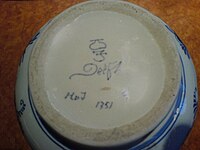Delft blue

Delft blue ( Dutch : delfts blauw ) is a type of faience with a blue decor, which is traditionally made in Delft . It emerged at the end of the 16th century as a cheaper alternative to blue and white Chinese porcelain. The Delft Blue became very popular in a short period of time and flourished between 1650 and 1750 when Delft had hundreds of ceramic companies. This industry was largely supplanted by cheaper pottery from England ( Staffordshire ) around 1800 . Today there is only one factory in Delft that continues to produce Delft blue in an unbroken tradition. Other Delft pottery are the multi-colored Boerendelfts ( Farmer's Delft ) and the Delft White .
origin
In the 16th century, Flemish potters introduced tin glaze in the northern Netherlands, replacing the older lead glaze . This type of ceramic originated in Italy in the 15th century and is also known as majolica . At the end of the 16th century, the Portuguese and later the Dutch introduced Chinese porcelain with its distinctive blue paint to the Netherlands. This imported porcelain was fine and delicate and immediately gained great popularity. But only the rich could afford it. The Delft majolica potters, who could not make real porcelain, began to imitate it. This first happened as a light yellow pottery, covered with a white tin glaze, into which colored decorations were incorporated.
By adding marl , the majolica manufacturers were able to improve their product, the shards became thinner and were now called faience. Initially, the Delft potters mainly applied oriental decorations to their products. Later, however, these images were replaced by genuinely Dutch scenes. The Delft faience became known nationwide as Delft Blue. This was such a success that in 1700 there were 33 pottery factories in Delft alone. However, the potteries not only produced fine exhibits, but also many simple everyday objects. Each workshop had its own brand, which had to be approved by the Delft Council.

A large part of the blue color came from the Black Forest, where it was produced in color mills from the cobalt ore extracted in the mining pits and later also imported , for example in Wittichen or Alpirsbach , and transported on rafts via Utrecht to Delft.
Heyday
The vases , candlesticks and especially the crockery (everyday crockery and ornaments) are particularly famous . The first Chinese porcelain to be imported into the Netherlands by the Dutch East India Company came from the Ming Dynasty . This explains why many of the Delft products, even after the end of this dynasty (1644), are decorated with typical ming-like or Wanli motifs. But the Delft blue is more than just a cheap stoneware copy of Chinese porcelain. In the 17th century Delft ceramic painters such as Isaac Junius, Frederik van Frytom and Arie de Milde brought the quality of their products to an unprecedented level. Your end products are real works of art. With new painting and burning techniques, they were always good for new surprises.
Decline
A large number of the companies disappeared in the second half of the 18th century. In 1794 there were ten manufacturers left. With the advent of cheap but high quality English pottery, there was less demand for Delft blue, so Dutch earthenware was supplanted.
Founded in 1653, De Koninklijke Porceleyne Fles (also known internationally under the name Royal Delft ) is the only company that has been continuously producing Delft blue since the 17th century.
Nowadays, Delft is a place for lovers of traditional and contemporary ceramics thanks to numerous galleries.
reception
The term "Delft Blue" is not a protected trademark. It is mostly used for blue and white decorated ceramics. Not all blue and white ceramics were created in Delft, but rather have a similar appearance to this one. Many ceramic manufacturers used this name as a trademark for their own products, even if they were not made in Delft.
Paintings for passenger cars were also offered under the name Delft blue , for example from Volkswagen with the paint color number L55Z and the associated HEX code #162545.
Collections
Dutch museums with Delft blue in the collection:
- Gemeentemuseum The Hague
- Ceramic museum Princessehof in Leeuwarden
- Prinsenhof Museum in Delft
- Paleis Het Loo in Apeldoorn
- Rijksmuseum Amsterdam
- Rijksmuseum Twenthe
Literature and Sources
- MS van Aken-Fehmers, LA Schledorn, AG Hesselink, TM Eliëns: Delfts aardewerk. Geschiedenis van a national product. Part 1: Delfts aardewerk 1650-1800. Gemeentemuseum Den Haag, Waanders Uitgevers, Zwolle 1999, ISBN 90-400-9358-X .
- DF Lunsingh Scheurleer: Delfts blauw. Bussum 1975 OCLC 473497039 .
- J. Matusz: Delfts aardewerk. Gaade, Amerongen 1977 ISBN 90-6017-718-5 .
- Tin-glaze pottery in Europe and the Islamic world; the tradition of 1000 years in maiolica, faience & delftware. Faber, London 1973, ISBN 0-571-09349-3 .
Web links
- Geschiedenis van de Nederlandse tegel
- Royal Delft
- How did they produce Delft blue faience in the delftware potteries?
- Delft Blue on holland.com
- Netherlands: Delft blue in many colors. In: Der Spiegel Online 2003
Individual evidence
- ↑ Delfts Blauw manufacture . In: Delft.com . Retrieved November 10, 2018.
- ↑ Delft and the white and blue ceramics. In: ndr.de. June 5, 2017. Retrieved October 9, 2017 .
- ↑ Delft Aardewerk - Articles. Retrieved on October 11, 2018 : "een dunne, gelige scherf"
- ↑ Delft Aardewerk - Articles. Retrieved on October 11, 2018 : "tinglazuur aan alle zijden"
- ↑ Rudolf Metz: extraction of mineral raw materials in the Black Forest , Chapter 3: cobalt inking units (S. 7). In: Historical Atlas of Baden-Württemberg.
- ↑ Delft Aardewerk - Articles. Retrieved on October 11, 2018 : "alledaags gebruiksgoed, sierlijk gebruiksgoed, siergoed"
